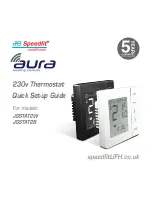
EN
WIKA operating instructions, model CTR3000
39
14191761.01 05/2019 EN/DE
6. Commissioning, operation
■
Conversion
The EMF-temperature characteristics of thermocouples are non-linear and the CTR3000 uses standard algorithms (from
IEC584) to convert the measured EMF to a temperature. Thermocouples can be calibrated individually to achieve better
measurement uncertainty. The calibration is presented as a deviation function polynomial.
a.
IEC 584 as defined in the standard
b.
TC polynomial like specified in the calibration certificate where t is the temperature in °C and ΔV is the correction in
millivolts.
ΔV = C
0
+ C
1
t + C
2
t
2
+ C
3
t
3
Thermocouples are standardised, and the reference function for the most common thermocouple types is defined
in IEC 584. The characteristic of individual thermocouples is usually close to the reference function. Therefore it is
recommended to determine the deviation function from the reference function for the thermocouple under test in
up to three temperature ranges, which must be indicated.
Make sure using the correct calibration parameters for the thermometer, since incorrect calibration parameters
lead to erroneous results. The coefficients can be found in the calibration certificate while ordered a calculation.
The coefficients of the calibration certificate have to be inserted inversed in the CTR3000. This makes the
calculation of the mV-signal in temperature values correct.
6.4.3.3
New probe [Thermistors]
1. To configure a new thermistor press the button
[Thermistor]
.
⇒
The menu with all settings opens on the right.
2. Enter the desired settings.
3. Confirm with button
[Store]
.
The CTR3000 can be used with thermistors. These are typically NTCs (negative temperature coefficient). Compared with
PRTs/SPRTs, thermistors have a much higher resistance (typically measured in tens of kΩ), operate over a more limited
temperature range (typically < 150 °C (302 °F)) and are highly non-linear (essentially logarithmic).
■
Probe name
Please enter an unique name (e.g. certificate number or serial number) for the new thermometer. This name is also shown
later under the existing probes and for this name a search can be done.
■
Reference
Please mark the thermometer as reference or not. This is important for the scan mode - see chapter 6.4.6 “Application
[Calibration]” because the difference between the first reference and the test item will be calculated and displayed in the
information bar.
















































